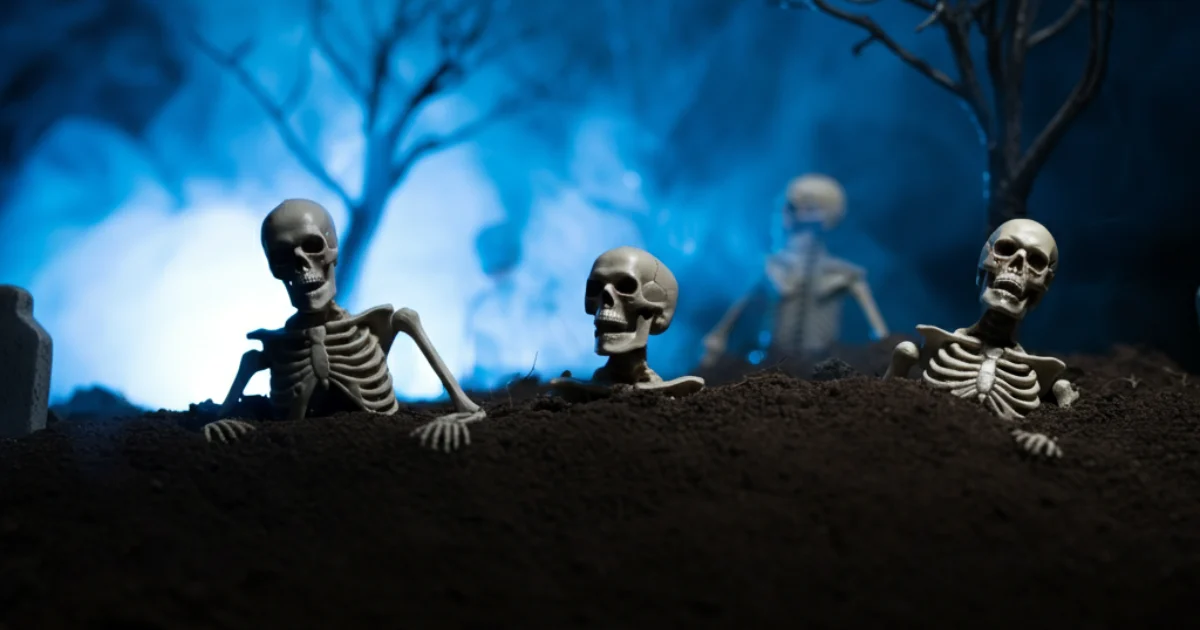Few horror films have left a mark quite like Poltergeist. Released in 1982 and directed by Tobe Hooper, this cinematic masterpiece blended supernatural thrills with groundbreaking practical effects. But behind its on-screen magic lies a startling fact that has captured the curiosity of fans for decades. Did you know Poltergeist used real skeletons during its production? This unusual decision has fueled years of rumors, controversy, and even claims of a “curse” tied to the film. Today, we uncover the story behind this unsettling truth.
The Truth Behind the Skeletons in Poltergeist
Movies have always relied on props to create an immersive experience, but the decision to use real skeletons in Poltergeist was by no means typical. The scene in question occurs when protagonist Diane Freeling (played by JoBeth Williams) falls into a muddy pool filled with skeletons during the film’s terrifying climax. While one might assume that these were simply plastic props, the truth is far stranger.
At the time, creating realistic fake skeletons was both expensive and time-consuming. The production team faced tight budget constraints, making authentic skeletons a more practical choice. Yes, actual human skeletons were cheaper to procure than creating convincing replicas. The bones used in the film were reportedly sourced through medical supply companies, as purchasing human skeletons for educational or film purposes was a common practice at the time.
While this budget-friendly decision may seem shocking today, it’s important to remember that advances in visual effects were still relatively limited in 1982. The film’s director, Tobe Hooper, prioritized realism in crafting the film’s scares, and the use of real skeletons certainly achieved that goal.
On-Set Reactions and Controversies
Using real skeletons might have been practical, but it wasn’t without its share of fallout. The cast, particularly JoBeth Williams, was initially unaware that the skeletons were real. When the truth came out, it understandably sparked discomfort among the actors and crew. Williams later expressed her unease during interviews, recounting how she was only informed about the decision after filming the infamous pool scene.
This revelation also stirred ethical concerns beyond the set. Was it appropriate to use human remains for entertainment? Though the practice was legal, critics have questioned whether it was a respectful use of these remains. Today, this decision invites debate about the boundaries of art, practical considerations, and morality in filmmaking.
The use of real skeletons added another layer of mystique to the film’s production, with fans speculating that this choice contributed to the so-called “Poltergeist curse.” Over the years, a string of tragic events, including the deaths of several young cast members, have sparked theories that the film was haunted. While these claims remain unverified, the inclusion of real skeletons undeniably adds to the film’s eerie legacy.
How Real Skeletons Elevated Poltergeist
From a cinematic perspective, the decision to use real skeletons had a significant impact on Poltergeist’s effectiveness as a horror film. The realism of the skeletons added a deeply unsettling authenticity to the scenes they appeared in. Plastic props, by comparison, likely wouldn’t have conveyed the same grotesque detail.
Horror films rely on immersion to truly terrify their audiences, and in Poltergeist, the uncanny authenticity of the skeletons played a vital role in achieving that immersion. It wasn’t just a visual effect; the knowledge that these were real remains added a layer of psychological horror that’s difficult to shake, even for viewers learning this fact decades later.
Modern Special Effects Versus Practical Effects
Fast forward to today, and the use of real skeletons in filmmaking has become virtually unheard of. Advances in computer-generated imagery (CGI) provide filmmakers with the ability to create ultra-realistic visuals without crossing ethical boundaries. Entire worlds, characters, and effects can now be rendered digitally at a fraction of the effort it once required.
But does CGI surpass practical effects when it comes to creating impactful horror? The debate continues. Modern technology offers flexibility but sometimes lacks the tangibility of in-camera effects. Practical effects, such as real props or makeup work, often provide a physical presence and weight that CGI can struggle to replicate. Viewers tend to “feel” the realism of practical effects in a way that’s more visceral, connecting them more deeply with the scene’s tension.
For films like Poltergeist, which relied heavily on practical effects, the use of real skeletons epitomized the raw, hands-on approach that defined horror filmmaking in the pre-CGI era. While today’s production teams favor ethical standards and digital wizardry, it’s hard to deny the unsettling power that Poltergeist achieved through its daring choice.
Lessons from Poltergeist’s Legacy
The story of real skeletons in Poltergeist offers more than a shocking tidbit for movie trivia enthusiasts. It’s a striking example of the lengths filmmakers will go to achieve their artistic vision, even in the face of ethical and practical challenges. Though it’s unlikely that Hollywood will return to such methods, Poltergeist remains a reminder of how far practical effects can push the boundaries of filmmaking.
If anything, this tale underscores the importance of balancing creativity with consideration. Advancements in technology now allow filmmakers to create without resorting to morally gray decisions—but the legacy of films like Poltergeist proves that practical effects, no matter how unconventional, leave a lasting impression on audiences.
Whether you’re revisiting this classic or experiencing it for the first time, knowing the story behind the skeletons adds a whole new layer of appreciation (and perhaps unease) to its legacy.


